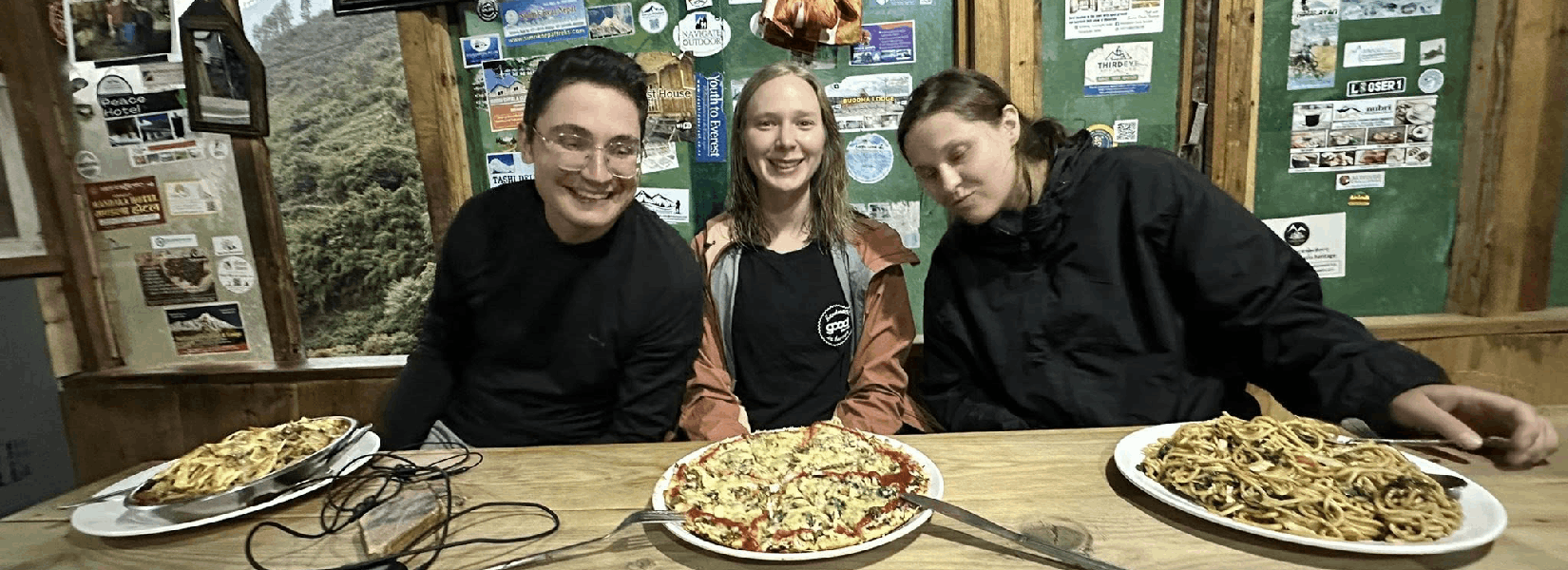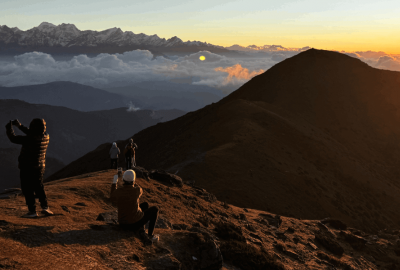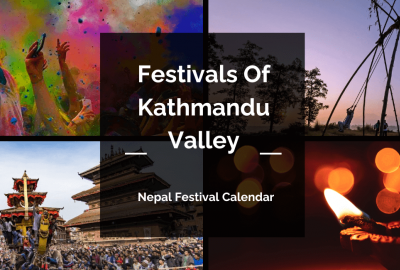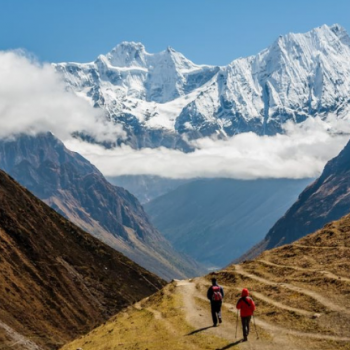The Manaslu Circuit Trek takes you through one of Nepal's most remote and culturally rich regions, and the food you'll encounter along the way is as diverse as the landscapes you'll traverse. From traditional Nepali dal bhat to Tibetan-influenced dishes in the higher villages, understanding what to eat and drink on this trek is essential for maintaining energy, proper acclimatization, and overall enjoyment of your journey.
Table of Contents
Plan your trip to Nepal
Customize your trip with help from a local travel specialist.
The Teahouse Dining Experience
Unlike camping treks, the Manaslu Circuit follows a teahouse route, meaning you'll eat at lodges along the trail. However, it's important to understand that this trek is far more remote than popular routes like Annapurna or Everest Base Camp, which significantly impacts food availability and variety.
What to Expect
Lower Sections (Soti Khola to Namrung, 700m-2,660m): The teahouses in the lower regions are relatively basic but offer a decent variety of food. Menus are more diverse, and fresh vegetables and ingredients are more readily available since supplies can be transported more easily from lower valleys.
Middle Sections (Namrung to Samagaun, 2,660m-3,530m): As you climb higher, menu options begin to narrow. The teahouses are comfortable but provisions are limited to what can be carried by porters or pack animals. Expect heartier, simpler meals with less variety.
Upper Sections (Samagaun to Dharamsala, 3,530m-4,460m): At the highest villages before the pass, food becomes quite basic. Fresh produce is scarce or non-existent, and you'll rely heavily on preserved foods, rice, noodles, and canned goods. The limited menu reflects the extreme difficulty of transporting supplies.
Pass Day (Larkya La to Bimthang): Most lodges at Dharamsala provide only basic breakfast before your early morning departure. You'll carry snacks for the pass crossing and won't eat a proper meal until reaching Bimthang.
Traditional Nepali and Tibetan Dishes
Dal Bhat - The Trekker's Best Friend
Dal bhat is the staple meal of Nepal and will become your most reliable companion on the Manaslu Trek. This traditional dish consists of:
- Dal: Lentil soup, providing essential protein
- Bhat: Steamed rice, your primary carbohydrate source
- Tarkari: Vegetable curry (varies based on availability)
- Achar: Spicy pickle condiment
- Sometimes included: Papad (crispy lentil wafer), small portions of potato, or spinach
Why dal bhat is ideal for trekking:
- Unlimited refills ("dal bhat power, 24 hour!") - most teahouses offer free seconds
- Balanced nutrition with carbohydrates, protein, and vegetables
- Hot meal that helps maintain body temperature at altitude
- Usually the freshest option since ingredients are staples that keep well
- Generally safe as it's cooked thoroughly
- Most affordable meal option
Pro tip: Dal bhat at higher altitudes becomes increasingly basic. The dal might be thinner, vegetables scarcer, and accompaniments fewer, but it remains your most reliable energy source.
Tibetan-Influenced Dishes
As you enter the upper Manaslu region, the cultural influence shifts from Nepali to Tibetan Buddhist, reflected in the cuisine:
Thukpa: Tibetan noodle soup with vegetables and sometimes egg or meat. This warming dish is perfect for cold evenings at altitude and provides both hydration and nutrition. The broth helps with altitude acclimatization.
Thenthuk: Hand-pulled noodle soup similar to thukpa but with flat, torn noodles. Heartier and more filling, this is excellent before a challenging trekking day.
Sherpa Stew: A thick, hearty stew with potatoes, vegetables, and sometimes yak meat or cheese. Particularly good at higher elevations for its warming properties.
Momo: Tibetan dumplings, either steamed or fried, filled with vegetables, cheese, or meat. While delicious, fried momos should be avoided at higher altitudes as fried foods are harder to digest.
Tibetan Bread: Fried flatbread, often served with honey, jam, or cheese. Great for breakfast but heavy and greasy - better consumed at lower altitudes.
Tingmo: Steamed Tibetan bread, lighter than fried bread and easier on the stomach at altitude. Often served with curry or stew.
Tsampa: Roasted barley flour, a traditional Tibetan staple. Usually mixed with butter tea to form a dough-like consistency. Highly nutritious and commonly eaten by locals and Sherpas.
Rice and Noodle Dishes
Fried Rice: Vegetable, egg, or mixed fried rice is widely available and generally safe. However, the quality and portion sizes decrease at higher altitudes. Can be somewhat oily and heavy on digestion.
Chow Mein: Stir-fried noodles with vegetables and optional egg. Popular among trekkers, though quality varies significantly. At higher villages, this might be quite basic with minimal vegetables.
Spaghetti: Some lodges offer basic pasta dishes, though these are usually just boiled noodles with tomato sauce from a can. Not particularly authentic but sometimes a welcome change.
Breakfast Options
Starting your day with a substantial breakfast is crucial for trekking energy. Common options include:
Porridge (Oatmeal): Served with sugar, honey, or sometimes fruit. Excellent for altitude as it's easy to digest and provides sustained energy. Can request it with hot milk for extra calories.
Tibetan Bread: As mentioned, fried flatbread with accompaniments. Fill it with peanut butter, jam, honey, or cheese for extra calories.
Pancakes: Usually basic flour pancakes, sometimes with apple or banana when available. Can be served with honey, jam, or sugar. Not as nutritious as porridge but psychologically comforting.
Eggs: Boiled, fried, scrambled, or as an omelet. Eggs are available throughout most of the trek and provide excellent protein. However, at the highest points (Samdo, Dharamsala), eggs may not be available or may be powdered.
Muesli: Some lodges offer muesli or cornflakes with milk (usually powdered milk at higher altitudes).
Toast with Toppings: White bread toast with butter, jam, peanut butter, or cheese. Simple but effective for energy.
Chapati: Unleavened whole wheat flatbread, healthier than fried Tibetan bread and easier to digest at altitude.
Snacks and Trail Food
Carrying your own snacks is essential, especially for long trekking days and the pass crossing:
Available at Teahouses:
- Biscuits and cookies (various brands)
- Chocolate bars (Mars, Snickers, local Nepali brands)
- Instant noodles
- Peanuts and roasted soybeans
- Potato chips (limited at higher elevations)
- Energy bars (rare and expensive - better to bring from Kathmandu)
Should Bring from Kathmandu:
- Energy/protein bars
- Trail mix or dried fruits
- Nuts (almonds, cashews, walnuts)
- Chocolate or candy for quick energy
- Electrolyte tablets or powder
- Your favorite comfort snacks
Local Snacks to Try:
- Sel roti: Sweet, ring-shaped rice bread, available in lower villages
- Churpi: Hard dried yak cheese, available in upper regions - extremely hard but nutritious
- Dried meat: Yak or buffalo jerky in upper villages (only if your stomach is well-adjusted)
Beverage Options
Proper hydration is absolutely critical for altitude acclimatization on the Manaslu Trek.
Water
Boiled Water: All teahouses provide boiled water for a small fee (usually 100-300 NPR per liter, increasing with altitude). This is the safest and most environmentally friendly option.
Filtered/Purified Water: Some lodges have water filtration systems, though this is less common on Manaslu than on more developed routes.
Bottled Water: Available in lower sections but becomes scarce and expensive higher up. Environmentally problematic as plastic waste is a significant issue in the Himalayas.
Stream Water: Never drink untreated stream water. Always boil, filter, or use purification tablets. Bring a reliable water filtration system (like a SteriPEN, LifeStraw, or Sawyer filter) and water purification tablets as backup.
Pro tip: Fill your water bottles with hot boiled water in the evening. They'll act as hot water bottles in your sleeping bag, and you'll have water to drink in the morning (important as mornings are extremely cold at altitude).
Hot Beverages
Hot drinks are essential for warmth, hydration, and morale at altitude:
Tea:
- Black tea (Chiya): Basic black tea, usually quite sweet
- Milk tea (Doodh chiya): Tea boiled with milk and sugar, Nepali-style
- Lemon tea: Black tea with fresh lemon (when available) and honey
- Ginger tea: Excellent for digestion and nausea at altitude
- Honey-lemon-ginger tea: The ultimate altitude sickness prevention drink
- Herbal teas: Limited variety, but some lodges offer mint or other local herbs
Tibetan Butter Tea (Po Cha): A traditional Tibetan drink made with tea, yak butter, and salt. It's an acquired taste - salty and greasy - but incredibly warming and calorie-dense. Locals drink this throughout the day at high altitude. Worth trying for the cultural experience.
Coffee:
- Instant coffee (Nescafe) is universally available
- Quality is basic but provides caffeine
- Some lodges in larger villages may have filter coffee
- Becomes more expensive at higher altitudes
Hot Chocolate: Comforting and warming, usually made from powder mix. Good for evenings but not as beneficial for acclimatization as tea.
Hot Lemon: Simply hot water with lemon and honey - excellent for hydration and vitamin C.
Alcohol
Beer: Available in lower and middle sections (up to around Samagaun). Local brands include Gorkha, Everest, and Nepal Ice. Becomes expensive and scarce at higher elevations.
Raksi: Local distilled alcohol made from rice, millet, or other grains. Very strong. Some lodges brew their own.
Chang: Fermented millet or barley beer, mildly alcoholic and popular among locals.
Tongba: A unique Himalayan drink - fermented millet in a wooden container filled with hot water and sipped through a bamboo straw. Warming and social.
Important Warning: Avoid alcohol above 3,000 meters as it worsens altitude sickness symptoms, causes dehydration, and impairs acclimatization. Save celebrations for after you've crossed the pass and descended.
Dietary Considerations
Vegetarian Options
Nepal is extremely vegetarian-friendly. In fact, most trekkers eat vegetarian throughout the trek because:
- Meat quality is questionable at remote teahouses
- Refrigeration is minimal or non-existent
- Meat takes longer to digest at altitude
- Vegetarian options are fresher and safer
- Dal bhat and most traditional dishes are naturally vegetarian
Vegan Options
Veganism is more challenging but manageable:
- Dal bhat can be made vegan (skip the curd/yogurt)
- Request vegetables cooked without ghee (clarified butter)
- Tibetan bread and chapati are usually vegan
- Many soups and noodle dishes can be adapted
- Inform your guide early so they can communicate with teahouse owners
Gluten-Free
Gluten-free trekking is very difficult in Nepal:
- Bring your own gluten-free snacks and supplements
- Rice-based meals (dal bhat without chapati) are your staple
- Potatoes are safe
- Communicate your needs clearly to lodge owners
- Many noodles and breads contain gluten
Food Allergies
If you have severe food allergies:
- Bring an allergy translation card in Nepali
- Inform your guide who can communicate with lodge owners
- Carry emergency medication (EpiPen if needed)
- Consider bringing some of your own safe packaged foods
- Be prepared for cross-contamination in kitchen facilities
Food Safety and Hygiene
Reducing Risk of Illness
Safe Food Choices:
- Thoroughly cooked hot meals
- Dal bhat (cooked to order and served hot)
- Boiled eggs
- Foods cooked in boiling water (soups, noodles)
- Freshly cooked vegetables
- Rice and lentils
Foods to Approach Cautiously:
- Raw vegetables and salads (washing water may be contaminated)
- Meat and dairy at high altitude (refrigeration is inadequate)
- Fried foods (oil may be reused repeatedly)
- Foods sitting out at room temperature
- Unpasteurized dairy products
Hygiene Practices:
- Wash or sanitize hands before eating
- Use your own utensils when possible
- Avoid shared water bottles
- Be cautious with communal condiments
- Observe kitchen cleanliness (though you won't always have access)
Altitude and Digestion
Your digestive system works differently at altitude:
Changes to Expect:
- Decreased appetite (very common above 3,500m)
- Slower digestion
- Increased gas and bloating
- Potential nausea
- Food aversions you don't normally have
Dietary Strategies:
- Eat smaller, more frequent meals
- Choose easily digestible foods (carbohydrates over proteins and fats)
- Avoid heavy, greasy, or spicy foods
- Continue eating even without appetite (you need the energy)
- Favor soups and liquid-based meals
- Avoid overeating before sleeping
Nutrition for Altitude
Macronutrient Balance
Carbohydrates (60-70% of calories): Priority at altitude because they require less oxygen to metabolize. Focus on rice, potatoes, bread, noodles, and porridge.
Proteins (15-20%): Important for muscle recovery but harder to digest at altitude. Lentils, eggs, and beans are your best sources. Avoid heavy meat dishes above 3,500m.
Fats (15-20%): Necessary for calories and warmth but digest slowly. Cheese, peanut butter, and nuts in moderation. Your body needs extra calories at altitude (often 4,000-6,000 per day).
Key Nutrients
Iron: Important for oxygen transport. Found in lentils, spinach, and eggs.
Vitamin C: Supports immune function. Request lemon in your tea frequently.
Electrolytes: Lost through increased urination at altitude. Add electrolyte tablets to your water.
Antioxidants: May help with altitude adaptation. Found in colorful vegetables when available.
Sample Daily Meal Plan
Lower Elevations (1,000-2,500m)
Breakfast: Porridge with honey and milk, 2 boiled eggs, black tea Lunch: Vegetable fried rice with mixed vegetables, lemon tea Snacks: Biscuits, chocolate bar, peanuts on the trail Dinner: Dal bhat with vegetable curry and papad, ginger tea Evening: Hot lemon with honey before bed
Mid Elevations (2,500-3,500m)
Breakfast: Tibetan bread with peanut butter and jam, scrambled eggs, milk tea Lunch: Vegetable thukpa (noodle soup), ginger-lemon tea Snacks: Energy bar, dried fruits, lots of water Dinner: Dal bhat (ask for seconds), herbal tea Evening: Hot chocolate for warmth
High Elevations (3,500-4,460m)
Breakfast: Oatmeal porridge with sugar, 2 boiled eggs (if available), honey-lemon-ginger tea Lunch: Sherpa stew or simple vegetable soup, crackers, hot lemon Snacks: Chocolate, nuts, electrolyte water throughout the day Dinner: Dal bhat (even if appetite is low, try to eat), ginger tea Evening: Hot water with honey, maybe garlic soup (helps with altitude)
Pass Day (Dharamsala to Bimthang)
Pre-dawn: Light breakfast - porridge or bread with tea (at 2-3 AM) Trail snacks: Energy bars, chocolate, dried fruits, nuts every 1-2 hours Water: Frequent small sips (water may freeze, so use insulated bottles) Post-pass: Large celebration meal at Bimthang - whatever sounds good!
Menu Price Expectations
Prices increase significantly with altitude due to transportation costs:
Lower sections (700-2,500m):
- Dal bhat: 400-600 NPR
- Fried rice/noodles: 300-500 NPR
- Soup: 200-350 NPR
- Tea: 50-100 NPR
- Breakfast items: 200-400 NPR
Middle sections (2,500-3,500m):
- Dal bhat: 600-800 NPR
- Fried rice/noodles: 500-700 NPR
- Soup: 300-450 NPR
- Tea: 100-150 NPR
- Breakfast items: 300-500 NPR
Upper sections (3,500m+):
- Dal bhat: 800-1,200 NPR
- Fried rice/noodles: 700-1,000 NPR
- Soup: 400-600 NPR
- Tea: 150-250 NPR
- Breakfast items: 400-700 NPR
- Boiled water: 200-400 NPR per liter
Note: Prices fluctuate and increase annually. Bring sufficient cash as there are no ATMs after Soti Khola.
Special Tips for Food Success
Order Early: During peak season (October-November, March-May), teahouses can be busy. Order your dinner when you arrive so the kitchen has time to prepare.
Eat Where You Sleep: Most lodges offer free accommodation if you eat all meals with them. This is the standard system.
Be Patient: Cooking at altitude takes longer due to lower boiling temperatures. Don't expect fast service, especially for rice-based dishes.
Variety Strategy: If eating the same food becomes monotonous, alternate between dal bhat, noodle soups, and other options, but return to dal bhat regularly as it's most reliable.
Trust Dal Bhat: When in doubt, order dal bhat. It's nearly always the safest, freshest option.
Communicate Dietary Needs: Tell your guide on day one about any restrictions so they can prepare lodge owners.
Bring Supplements: Consider multivitamins since fresh fruits and vegetables are scarce at higher elevations.
Don't Skip Meals: Even without appetite, eat something. Your body needs fuel for trekking and acclimatization.
Garlic Soup: Some trekkers swear by garlic soup for altitude prevention. Several lodges offer this specifically for altitude benefits.
Hot Water Bottle Service: Most lodges will fill your water bottle with hot boiled water for free or a small charge. Use this for warmth at night and drinking water in the morning.
Cultural Eating Etiquette
Use Right Hand: When eating with your hands, use only your right hand (left hand is considered unclean).
Remove Shoes: Take off shoes before entering dining areas.
Wait for Everyone: In group settings, wait until everyone is served before eating.
Finish Your Food: Try to finish what you order to avoid waste, but don't force yourself if feeling ill.
No Tipping in Lodges: Tips aren't expected for meals, but you can tip kitchen staff at the end if service was exceptional.
Respect Prayer Flags: Don't step over food or touch it to the ground where prayer flags are present.
Final Thoughts on Food and Drink
Food is fuel, comfort, and cultural experience on the Manaslu Trek. While the cuisine becomes increasingly basic as you ascend, the simple meals you share with fellow trekkers and lodge families often become cherished memories.
Approach food pragmatically: prioritize safety and nutrition over variety. Stay hydrated obsessively. Eat even when you don't feel like it. The humble dal bhat will carry you over the Larkya La if you let it.
Most importantly, maintain perspective. You're trekking through remote Himalayan villages where every grain of rice has been carried on someone's back. The simple meal you're eating represents extraordinary effort. Appreciate it, fuel your body, and save the culinary adventures for Kathmandu.
Ramro sanga khanuhola! (Eat well!)









